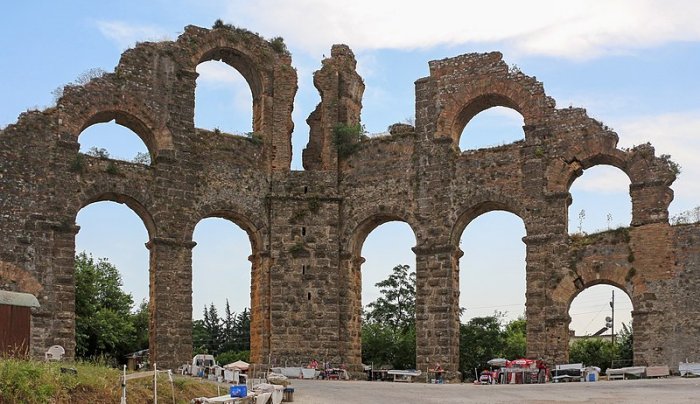There are thousands of breathtaking attractions in Turkey when it comes to interests of archeology and history. I made a list for you featuring ”8 Unmissable Archeological Attractions in Turkey”.
Aspendos Aqueducts (Aspendos Ancient City in Antalya)
The 1km-long and 15-meter-high Roman aqueducts used to bring water to Aspendos ancient city from the nearby river and mountains. Aspendos Aqueducts date to the second century AD. An inscription found in Aspendos ancient city states that it was built by Tiberius Claudius Italicus.

Grand Theater of Hiearapolis Ancient City (Denizli City)
The enormous and well-preserved Roman theater in the middle of the ancient city of Hierapolis (also known as Pamukkale), had a capacity of 8500-10000 spectators. Its construction started in 62 AD and completed in AD 206 during the emperor Severus Period. During the reign of Emperor Severus, the cavea and theater scene were restored using the remains of an old theater previously built to the north of the city.
Gerga Temple (Gerga Ancient City in Aydin)
The ancient city of Gerga is one of the most important centers reflecting the Karian culture. The most important structure of the city is the structure that is still standing and has the features that can be called a temple. There is an inscription on the pediment of the building made of large cut stones. It is thought that the colossal statue that fell on the ground just below the building may belong to Kybele.
Termessos Theater (Termessos Ancient City in Antalya)
Termessos Antique Theater is located in the ancient city of Termessos, to the west of Antalya. The theater, leaning on the hillside with a magnificent view of the Antalya Bay, is one of the most vivid and beautiful examples of Roman theaters. The most interesting aspect of this theater, with a capacity of 4000-5000 spectators and made of cut stones, is that it was built on the edge of the cliff.
Gobeklitepe (SanliUrfa City)
It is the oldest known significant temple in the world. The 12,000-year-old circular structures made of animal figures, carved stones and T-shaped monoliths date back to before the transition into the agriculture. The largest of the T-shaped obelisks in Göbeklitepe exceeds 16 tons. Carving these stones and moving them from the nearby quarry would have required a demanding organization which should have needed numerous people and enough food to feed them all.
Celsus Library (Ephesus Ancient City)
Celsus Library of Ephesus was built by Tiberius Julius Acquila in memory of his father, Tiberius Julius Celsus Polemaeanus, who was the governor of Asia Minor between 105-107 AD. The construction of the building started in 114 AD and was completed by his grandchildren in 135 AD. The exterior of the building, which was built on two floors, is 17 meters high and 21 meters wide. It is estimated that there are approximately 9,500 to 12,000 scrolls in the library.
Antonines Fountain (Sagalassos Ancient City in Burdur)
Antonines Fountain is one of the most outstanding structures of Sagalassos Ancient City. It was built between 161-180 A.D. during the reign of Roman Emperor Marcus Aurelius and was dedicated to the god Dionysus. The Antonine Fountain’s water, which has flowed in the ancient city of Sagalassos for 1,800 years, is believed to beautify people according to mythology, and those who drink it to fall in love. The reason why the fountain is called “Antonine Fountain” is that it coincides with the Antonine period in the Roman Empire. There are statues of the God Dionysus on the far right and left of the fountain, which is 28 meters wide and 9 meters high. These remain in their original spots.
Council Building of Lycian Union (Patara City in Antalya)
This building was the Assembly building of the Lycian Union, which the famous thinker Montesquieu praised in his book “Spirit of Laws” as “the most perfect of the ancient world” in the context of democracy. Council Building of Lycian Union is one of the largest parliament buildings in ancient Anatolia. Its construction took place in the 2nd century BC following the official establishment of the Lycian Union. It went through several building phases during the Roman period and also gained the Odeon function as well as being a senate. The council building has a capacity of around 1400 people.
Hire Archeology Expert Tour Guide in Turkey
These eight monuments are just the tip of the iceberg when it comes to archeological treasures waiting for you in Asia Minor. Contact me to hire a professional licensed tour guide in Turkey. See you soon, Hasan Gülday.